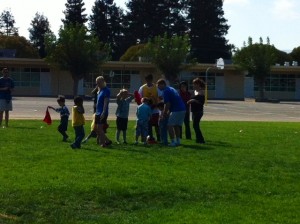by Danika Ziemer
E-Soccer kicked off this past Saturday morning! For those of you who have never heard of E-Soccer, it’s a program designed for able-bodied children as well as those with
special needs. Children as young as two years old to those in their mid-teens come out to the field for an hour every Saturday. E-Soccer is held in ten different locations in Northern California and one location in Las Vegas. The program is now global with sites in India and Kenya. At the Sunnyvale location, students at SJSU join with students from Santa Clara University to lead the 5-6 year old children in various adapted drills and games to improve the children’s soccer and teamwork skills. The kids, and coaches, have a blast playing games on “Soccer Island” or “Soccer Spaceship.”
E-Soccer is based on inclusion, which is vital for children to learn at such a young age. It’s incredible to see how well children and special needs children learn to interact and work with each other so quickly. Some kids need a one-on-one coach to help them through the program, but all of the kids work together and cheer each other on throughout the practice. These kids are so energetic and silly that it’s impossible not to have a good time on the field. I have been a coach at E-Soccer for almost a year now. I can safely say that those kids have made a larger impact on my life than I could ever possibly make on theirs, and I’m sure the other coaches would agree. I definitely believe that every student should come and check out the program.
We could always use more coaches, so if you’re interested in getting involved, e-mail the Kin Ambassadors Club at sjsukinambassadors@gmail.com. You can also check out the website at www.e-soccer.org.


